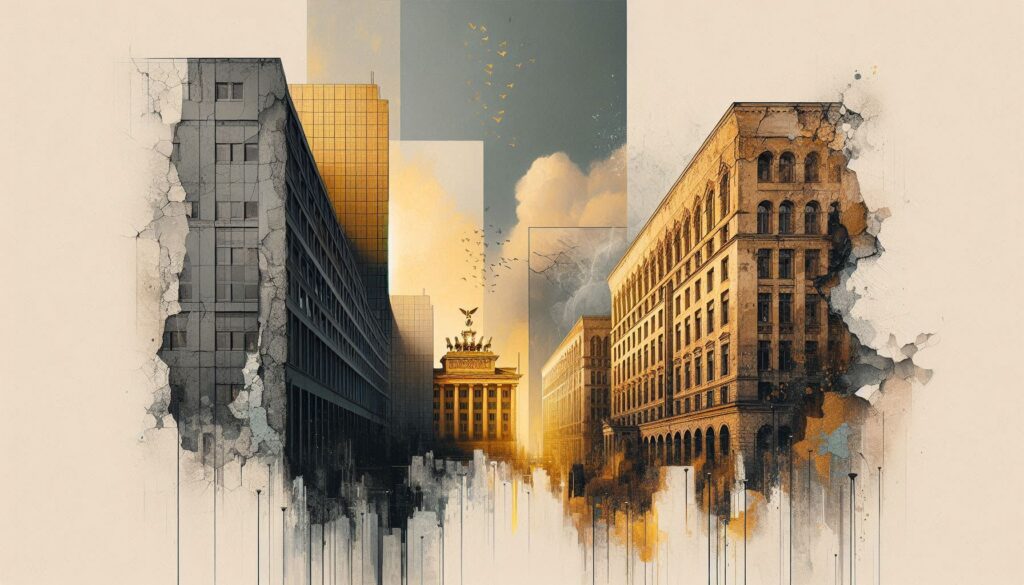
There’s a particular slant of afternoon light that hits the crumbling stucco of Neukölln, turning decay into something almost devotional. I’ve spent years trying to capture this in my work—the way beauty here refuses to arrive pristine, how it insists on wearing its scars like jewelry. Berlin doesn’t believe in the separation of things. Grit and grace aren’t opposites here; they’re lovers, conspirators, two hands braiding the same rope.
I moved here when I still believed cities could be solved like design problems, when I thought contrast meant choosing sides. The aesthetic purity I’d been trained to worship felt suddenly adolescent against Berlin’s sprawling, contradictory presence. This city is a living collage—Soviet concrete bleeding into Art Nouveau flourishes, techno cathedrals rising from abandoned power plants, immigrant markets spilling color across grayscale socialist architecture. Nothing matches. Everything belongs.
What Berlin taught me is that transformation isn’t about erasing—it’s about layering. Walk through any neighborhood and you’ll see it: bullet holes preserved in facades beside sleek glass insertions, graffiti aging into historical document, memorials growing like moss in the cracks of commerce. The city wears its violence, its divisions, its reinventions all at once. It refuses amnesia. And somehow, in that refusal, grace emerges—not despite the damage, but through it.
The alchemy happens in the margins. In Kreuzberg cafés where Turkish grandmothers drink çay beside hungover DJs, where the smell of döner mingles with privilege and everyone pretends not to notice the rent rising like floodwater. In Friedrichshain courtyards where wild gardens reclaim what was never really tamed, where someone’s always building something—a sculpture, a community, a resistance to the way things are supposed to be.
I think often about kintsugi, the Japanese art of repairing broken pottery with gold. Berlin practices this on an urban scale. The gold here isn’t literal—it’s the parties in abandoned buildings, the art studios in former factories, the way people transform trauma into techno, oppression into opera, emptiness into experimentation. The breaks are illuminated rather than hidden. The city says: yes, I was broken. Look how I glow now.
But grace without grit would be gentrification—that smooth, soulless renovation that erases context in favor of comfort. Berlin’s grace is feral, earned through survival rather than bestowed by design committees. It lives in the Späti owner who extends credit when you’re broke, in the stranger who helps carry your bike up five flights, in the collective gardens blooming on land nobody wanted until everyone did. This isn’t the grace of museums and monuments. It’s the grace of mutual survival, of people making beauty from whatever materials totalitarianism and capitalism left behind.
The tension is generative. Standing on Oberbaumbrücke at dusk, watching the Spree reflect tower blocks and television towers and clouds that don’t care about borders, I feel it: the productive friction between what was and what’s becoming, between preservation and progression, between the weight of history and the lightness of possibility. Berlin’s balance isn’t stable—it’s a controlled fall, a deliberate improvisation, a dance with no final form.
As a designer, I’ve learned to work differently here. My aesthetic has loosened, embraced imperfection, found rhythm in asymmetry. Berlin taught me that too much grace becomes sterile, too much grit becomes nihilistic, but together—in conversation, in conflict, in constant negotiation—they create something livable. Something true.
The alchemy of contrast isn’t about resolution. It’s about holding multiple truths simultaneously: that Berlin is both brutal and tender, both haunted and hopeful, both falling apart and perpetually rebuilding. The city doesn’t choose between grit and grace. It compounds them, ferments them, transmutes them into something that can only exist here, in this impossible, essential place.
Maybe that’s what keeps us here, those of us who stayed long enough to stop being tourists in our own lives. Not the perfect balance—Berlin will never be perfect—but the permission to be multiple things at once. To be broken and whole. To make art from ruins. To find grace not in spite of the grit, but as its inevitable companion, its shadow, its proof that beauty can be earned rather than inherited.
The light is fading now on that Neukölln wall. Tomorrow it will illuminate something else. This is how Berlin teaches: through transformation, through layers, through the radical act of becoming without erasing what you were. The alchemy continues. We’re all material in the experiment.

No results available
Reset